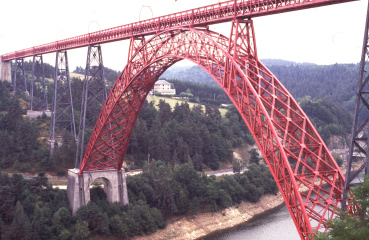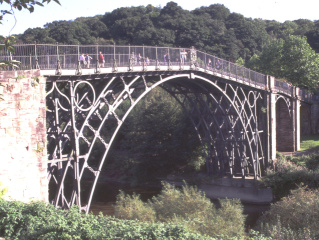 |
Teaching Material for use in SchoolsBridge Design |
| Engineering Department > Structures Group |
 |
Teaching Material for use in SchoolsBridge Design |
 |
This page has been constructed by Heather Lalupu and Chris Burgoyne. The material was produced by Heather as part of her 4th year undergraduate project in 2008. The work was carried out in association with the Institution of Structural Engineers Educational Trust. |  |
| An unusual bridge in Edinburgh |
Bridges come in all shapes and sizes, and are obvious examples of both the art and science of Structural Engineering. The Bridges teaching module contains three cross-curricular activities that tie in with the GCSE syllabus for mathematics, physics and design and technology. The teaching material has been developed in association with the IStructE Educational Trust and the University of Cambridge, following a study that looked at how to promote physics in schools.
There are three separate activities, which are desiged to be taken in sequence but can be done separately. They are Design Decisions (DT), Cable Stayed Bridge Model (Maths) and Bridge Reactions (Physics). Each activity is designed to require minimum preparation time from the teacher and should take around an hour to complete. Student worksheets and overhead presention slides are provided for each activity along with supporting teachers' notes with background information and worked solutions. Each module is summarised below, and each includes several files that can be downloaded, some of which are quite large. All materials can be copied and used for educational purposes provided that they are not altered and the source is acknowledged. Any suggestions for improvements to these materials, or feedback on how well the materials work, should be sent to Chris Burgoyne at the University of Cambridge (cjb@eng.cam.ac.uk).
The Design Decisions activity is aimed at students taking KS4 in Design Technology Resistant Materials. The students have to decide what type of bridge to use in different circumstances; there are five different worksheets that can be given to different groups and an extension worksheet to stretch the more able pupils. The students are given cost data for different types of structure and have to decide which to use in each case. The students have to work in groups and have to reach a decision in the same way as a professional engineer. The figures are slightly simplified but the results are realiistic and the students have to do some calculations to arrive at their answers.
Files to download (as a Zip file):- Teacher's powerpoint presentation; Teacher'sGuidance Notes; StudentWorksheet
| The cut out model of the harp bridge should look like this! |
Files to download (as a zip file):-
Teacher's powerpoint presentation; Teacher's Guidance Notes; Cutout models; StudentWorksheet
This exercise is intended to reinfroce the ideas of equilibrium of forces and moments in such a way that the students can visualise the way the reactionschange as a load moves across a bridge. The students use top-pan balances or force meters to "see" the forces directly. They should learn that all of the force applied to a bridge has to be reacted to the ground. The extension activity involves the students plotting graphs of the data they obtained in the practical experiments.
| A Prestressed Concrete Bridge in London |
Files to download:-
Teacher's powerpoint presentation; Teacher's Guidance Notes; Student Worksheet
We would like to thank David Mackenzie of Flint and Neill and the Institution of Structural Engineers Educational Trust for their assistance in producing these materials. We would also like to thank the staff and pupils of St Catherine's School, Twickenham; the Leys School, Cambridge; St Joseph's School, Cornwall; Launceston College, Cornwall and Hedingham School, Essex for trialling these modules and giving valuable feedback or for other assistance. The photographs in the text and in this page are taken by the authors or are taken from copyright-free web sites.
 |
 |
Garabit Viaduct in France, by Eiffel |
Ironbridge |
Other Teaching Materials produced by CUED
Why study Civil Engineering at Cambridge
Admissions Prospectus for Cambridge University Engineering Department
Institution of Structural Engineers Educational Trust